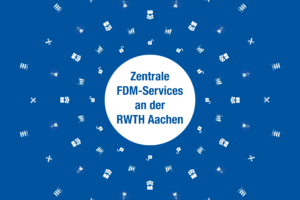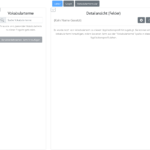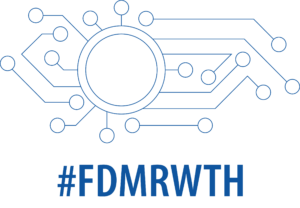Dieser Beitrag ist Teil unserer FDM-Reihe „Zentrale FDM-Services an der RWTH Aachen“. Sie soll unseren Forschenden – also Ihnen – aufzeigen, welche FDM-Services an der RWTH angeboten werden, um Sie in Ihrer Forschung und Ihrem Datenmanagement zu unterstützen. Wir sprechen mit den Serviceverantwortlichen und sammeln alle Informationen für Sie in den einzelnen Beiträgen. In diesem Beitrag möchten wir Ihnen den FDM-Service „AIMS“ vorstellen.
Wichtige Fakten
- Offizieller Name des Service: AIMS – Application Profile Service
- Link zur Startseite des Service: https://coscine.rwth-aachen.de/coscine/apps/aimsfrontend/#/editor
- Zielgruppe: Forschende
- Art: FDM-Plattform
- Seit Ende 2021 im Regelbetrieb an der RWTH Aachen verfügbar
Beispiel eines Nutzungsszenarios von AIMS
Eine Forscherin oder ein Forscher der RWTH plant, ihre Daten mit Coscine zu speichern und möchte, dass diese Daten mit bestimmten Metadaten versehen werden. Zum Beispiel mit dem/der Autor*in, den Einstellungen des Messinstruments, dem Datum der Erfassung und so weiter. Hierfür wird AIMS verwendet: Es können entweder Applikationsprofile (individuelle Metadatenprofile), die von anderen erstellt wurden und thematisch zu den eigenen Metadaten passen, ausgewählt werden. Oder es können neue Applikationsprofile erstellt werden. AIMS bietet eine große Auswahl an Einstellungen: Listen können erstellt, die erforderlichen Metadatenfelder festgelegt, Feldbeschreibungen hinzugefügt und sogar reguläre Ausdrücke verwendet werden, um Metadatenfelder zu überprüfen.
AIMS ist ein Teilservice von Coscine. Es bietet Ihnen – als Forscher*in – die Möglichkeit, Applikationsprofile zu erstellen, die Ihnen dabei helfen, passende Metadaten zu Ihren Forschungsdaten im Sinne der FAIR-Kriterien in Coscine zu speichern. AIMS unterstützt Sie dabei, Metadaten für wissenschaftliche Daten zu strukturieren und zu beschreiben. Außerdem übernimmt AIMS die Prüfung auf syntaktische Korrektheit. Applikationsprofile werden in Coscine in standardisierten Formaten geschrieben (SHACL) und zukunftsorientiert in das „Resource Description Framework“(RDF-Datenformat) überführt, was sie interoperabel und maschinenlesbar macht. Mehr zu diesen Formaten finden Sie ganz am Ende des Artikels.
Selbsterstelle Applikationsprofile können Sie im RDF-Datenformat herunterladen und zur Veröffentlichung und anschließenden Nutzung an Coscine senden. Vor der Veröffentlichung prüft das Coscine- und FDM-Team die technische Funktionalität.
Wer ist berechtigt, AIMS zu nutzen?
AIMS steht allen Forschenden zur Verfügung, die in ihren Projekten mit Coscine arbeiten. Sie müssen ein persönliches Coscine-Benutzertoken angeben, welches es Ihnen fortan erlaubt, Ihr Applikationsprofil direkt zu veröffentlichen. Ohne Benutzertoken kann ein Applikationsprofil nur lokal gespeichert werden. Mehr zur Erstellung eines Benutzertokens finden Sie ganz am Ende des Artikels.
Kontext zum größeren Ganzen: Welchen Zweck erfüllt AIMS in der modernen wissenschaftlichen Praxis? Welche Funktion hat der Service im modernen Wissensmanagement?
In der modernen wissenschaftlichen Praxis ermöglicht AIMS Forschenden eine einfache und effektive Erstellung und Verwaltung von Applikationsprofilen. Applikationsprofile bieten eine standardisierte Methode zur Beschreibung und Verwaltung von Metadaten, was die Auffindbarkeit und Nachnutzbarkeit von Daten erheblich verbessert und die Einhaltung der FAIR-Prinzipien erleichtert. AIMS bietet viele Vorteile, indem es die Strukturierung und Beschreibung von Forschungsdaten standardisiert und somit die Nachnutzung und Integration fördert.
Weitere Informationen
AIMS ist eine Open-Source-Plattform, die von der Beteiligung der Community lebt. Bei Fragen und Anregungen wenden Sie sich bitte unter dem Betreff „AIMS“ an den Servicedesk: Wir helfen Ihnen gerne weiter.
Alle wichtigen Seiten auf einen Blick
- AIMS: https://coscine.rwth-aachen.de/coscine/apps/aimsfrontend/#/editor
- Dokumentation: https://docs.coscine.de/de/metadata/generator/about/
- AIMS Video Tutorials: https://docs.coscine.de/de/metadata/generator/guide/
- Coscine: https://about.coscine.de/faq/
- Newsletter Coscine: https://lists.rwth-aachen.de/postorius/lists/coscine.lists.rwth-aachen.de/
- Seite für reguläre Ausdrücke: https://regexr.com/
- Was ist SHACL: https://www.w3.org/TR/shacl/
- Was ist RDF: https://www.w3.org/RDF/
Die Informationen wurden uns freundlicherweise von Dr. Kseniia Dukkart zur Verfügung gestellt. Sie ist Data Steward am SFB/TRR 219, gehört zum zentralen FDM-Team der RWTH und berät Forschende unter anderem zur Nutzung von AIMS.







Schreibe einen Kommentar
Du musst angemeldet sein, um einen Kommentar abzugeben.